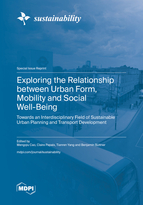Exploring the Relationship between Urban Form, Mobility and Social Well-Being: Towards an Interdisciplinary Field of Sustainable Urban Planning and Transport Development
A special issue of Sustainability (ISSN 2071-1050). This special issue belongs to the section "Sustainable Transportation".
Deadline for manuscript submissions: closed (1 December 2022) | Viewed by 34760
Special Issue Editors
Interests: transport planning; urban mobility; sustainable urban infrastructure and economics; urban planning; sustainable cities
Special Issues, Collections and Topics in MDPI journals
Interests: urban mobility; health geography; well-being; behavioural economics; urban science
Interests: urban analytics and modelling; urban spatial structure and travel; planning support systems for decision-making
Special Issue Information
Dear Colleagues,
This Special Issue focuses on exploring the relationship between urban form, mobility, and social wellbeing across neighbourhoods, cities, and regions. The relationships revealed would help to shape integrated sustainable urban planning and transport development strategies.
There is a growing amount of research examining changes in wellbeing in response to social and spatial interventions (e.g., inequality, social exclusion, built environment, land use, and transport development) and behavioural changes (e.g., travel preferences). However, there is a lack of understanding of the different types of wellbeing (e.g., social wellbeing, spatial nature of wellbeing, hedonic and/or eudaimonic wellbeing, short term/long term, individual/collective) and the resultant variations in impact. Furthermore, limited attention has been paid to the standardised measurement of wellbeing in both quantitative and qualitative terms in the field of social sciences, particularly with regard to social wellbeing and eudaimonic wellbeing, due to the fact that they are abstract concepts and thus difficult to assess accurately. Therefore, there is an urgent need to further explore the relationship between urban form, mobility, and social wellbeing, as well as to examine the ways in which different types of wellbeing (e.g., eudaimonic well-being) can be measured by applying various advanced models and research approaches.
The Special Issue aims to collect high-standard original empirical studies and review papers, which explore social wellbeing from the perspectives of urban planning, travel behaviour and mobility, within the field of social sciences. Potential topics include but are not limited to the followings:
- Travel behaviour, mode choice, and subjective wellbeing;
- Long-distance travel/commuting and wellbeing;
- Urban and transport-related social equity and meaningful social relationships and connections;
- Sociospatial analysis, changes in spatial structure and social wellbeing;
- Sustainable urban mobility, active travel, and social wellbeing;
- Accessibility, equal access to, and delivery of basic human needs (e.g., higher education and/or other key life activities) and opportunities for their advancement;
- Urban and transport-related social, hedonic, and eudaimonic wellbeing;
- Urban and regional development and/or physical and mental health issues related to travel behaviour;
- Urban form, land use planning, built environment, and social wellbeing;
- Health geography, geographies of wellbeing, hygienism, sanitarism;
- Urban modelling, big data analytics, and the measurement of social wellbeing;
- Sustainable cities, social inclusion, and quality of life.
This Special Issue will contribute to the existing literature on the interdisciplinary field of the impacts of urban planning and transport on social wellbeing, as well as facilitating a novel way of measuring an abstract concept of wellbeing (e.g., eudaimonic wellbeing).
Dr. Mengqiu Cao
Dr. Claire Papaix
Dr. Tianren Yang
Dr. Benjamin Büttner
Guest Editors
Manuscript Submission Information
Manuscripts should be submitted online at www.mdpi.com by registering and logging in to this website. Once you are registered, click here to go to the submission form. Manuscripts can be submitted until the deadline. All submissions that pass pre-check are peer-reviewed. Accepted papers will be published continuously in the journal (as soon as accepted) and will be listed together on the special issue website. Research articles, review articles as well as short communications are invited. For planned papers, a title and short abstract (about 100 words) can be sent to the Editorial Office for announcement on this website.
Submitted manuscripts should not have been published previously, nor be under consideration for publication elsewhere (except conference proceedings papers). All manuscripts are thoroughly refereed through a single-blind peer-review process. A guide for authors and other relevant information for submission of manuscripts is available on the Instructions for Authors page. Sustainability is an international peer-reviewed open access semimonthly journal published by MDPI.
Please visit the Instructions for Authors page before submitting a manuscript. The Article Processing Charge (APC) for publication in this open access journal is 2400 CHF (Swiss Francs). Submitted papers should be well formatted and use good English. Authors may use MDPI's English editing service prior to publication or during author revisions.
Keywords
- social well-being
- social equity
- quality of life
- behavioural change and decision making
- urban mobility
- travel behaviour
- sustainable transport development
- urban and transport modelling
- urban form
- urban planning
- sustainable cities









